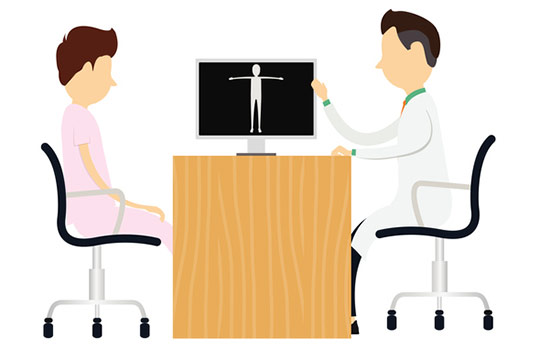Enabling patients to fully understand their diagnosis and treatment is something best done over a period of time, says Ceinwen Giles
 When I was told seven years ago that I had stage 4 non-Hodgkin lymphoma, I asked the doctor how many stages there were.
When I was told seven years ago that I had stage 4 non-Hodgkin lymphoma, I asked the doctor how many stages there were.
“Four”, she replied, casting me a sympathetic look. I would learn later that, as they say, there is no stage 5 (I had been thinking cancer probably operated more on a traditional one to 10 scale).
I remain undecided as to whether my ignorance of just how bad stage 4 cancer is was a good thing or a bad thing. My lack of knowledge of what is usually considered a death sentence gave me some respite from the terror and panic that came later, but it also meant that I wasn’t in a position to fully understand what was happening to me. New research by Macmillan indicates that I’m not alone.
Analysis of their 2016 patient experience survey shows that an estimated one in four people diagnosed with cancer in England did not completely understand the explanation of what was wrong with them, and more than a quarter say that they did not receive easy to understand written information about the type of cancer they have. The survey also reveals that almost half of cancer patients were not informed fully about the potential side effects of treatment. What are we to make of this?
In the aftermath of my own cancer experience, I’ve often thought about how long it took me to fully understand my diagnosis and treatment. Susan Sontag has written about how we all hold dual citizenship to the kingdoms of the well and the sick, but what I hadn’t anticipated was the need to understand the language of those kingdoms as well. As any patient will tell you, being diagnosed with an illness requires you to become fluent in the language of your disease—and, as we all know from school, learning a new language is no easy feat.
Being given a diagnosis and being expected to understand it the first (or even second) time surely sets the bar too high for the average person. In my own case, I was told that I had a large tumour in my mediastinum, a part of the body I had never even heard of. I was puzzled by the fact that I was to be given four “cycles” of chemotherapy rather than the eight or so “rounds” I found mentioned on many online lymphoma forums. I was given a printout of my treatment regimen, but this was written in formal medicalese and had not been translated for those with only a basic understanding of the language. That an “IT bolos injection, Cytarabine 70mg” would require an injection into my spine was not at all obvious to me. On a chemo break, I was given a printout of medications to take while at home, with side notes like “TID” and “QD,” which—having never learnt Latin (nor its abbreviations)—meant nothing to me.
This is not to say that I wasn’t given written information from other sources that were in plain English or that my doctors didn’t try to explain what was going on. I was not, however, in the right frame of mind to digest it. The shock of being diagnosed with a critical illness numbed me. While I’m detail oriented by nature, my mind seemed to shut down, preventing me from reading and absorbing all but the most basic of details. I was sick. I needed treatment. I wanted to get well.
And what of the side effects? Well, I was “consented” when I started chemotherapy. The side effects that I remember included failure of major organs, serious infection, death, and (my personal favourite) cancer. Caught between dying of cancer now or potentially dying of cancer later, I obviously chose the latter, but did I fully understand the ramifications of cancer treatment? No. I don’t think the long term mental or physical consequences were mentioned, though I can’t now be sure.
What the Macmillan research doesn’t tell us is how and when information is given to patients. Was it always given in person? Was it only given once? Were patients given a flyer and then sent on their way? It seems to me that enabling patients to fully understand their diagnosis, treatment, and potential side effects is something best discussed over a period of time, as the diagnosis and treatment evolve.
Unfortunately, for those looking for a quick fix, I suspect that what we need is more time—a system of checking in on patients regularly and face to face, which makes sure that they fully understand what is going on and gives them the time to ask questions as things progress. The questions one has at the start of an illness are likely to differ significantly to those one has months later. With the vast pressures facing the NHS and healthcare staff in particular, this sort of time gets increasingly squeezed out of schedules, but it is also the time that matters most.
Ceinwen Giles is a director at Shine Cancer Support and a trustee of the Point of Care Foundation. She also works as a consultant in patient involvement and experience and is an associate at Swarm.
Competing interests: I have received fees for consulting from GlaxoSmithKline UK. I’m a trustee of Shine Cancer Support and the Point of Care Foundation. My speaking engagements have had travel reimbursed (but no other fees paid) by a number of organisations: King’s Fund, Macmillan, Lymphoma Association, NHS Employers, NHS Confederation.
